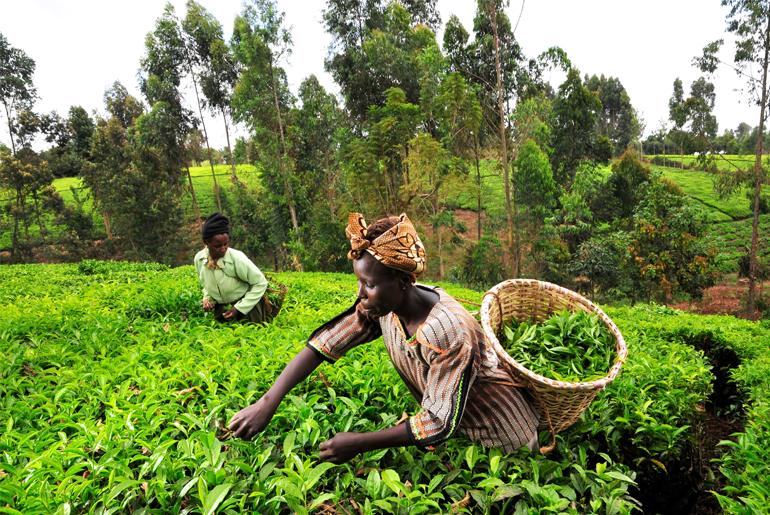Although Africa has 17% of the world’s pastures and arable land, the value of premiums for agricultural insurance in Africa represents less than 0.7% of the world’s total. This remarkably low figure is deplorable when one considers that about 60% of the active population in Africa is working in the agricultural sector and that with the advent of climate change the risks in agricultural activities are becoming even more frequent and severe (see 4 Major Themes for the Global World Economy).
The agriculture insurance sector in Africa is also unevenly distributed, with sector development in South and West Africa restricted to a handful of countries such as Nigeria, Benin, Senegal, Burkina Faso, Mali, and Ghana.
Earlier this year, a Grain SA survey indicated that 22% of grain producers in South Africa had lost more than 60% of their white maize plantings to water damage in 2022. Unfortunately, these events, such as the locust outbreak earlier this year and ongoing load shedding, continue to threaten farming assets, crops and livestock, leaving vulnerable farmers with mounting expenses.

For smallholder farmers, agriculture insurance offsets risks associated with weather fluctuations. This risk reduction can make it more likely that a farmer will qualify for credit and thus invest in the tools and resources (e.g. seed, fertilizer, labor) needed prior to harvest that would potentially increase crop yields. Furthermore, it also provides farmers with the peace of mind required to invest savings into businesses and increases their confidence to engage in contracts with buyers and processors.
South African farmers face countless challenges annually that threaten their valuable crops, livestock, and assets.
In addition, natural disasters like heavy rain, hail, drought, and other factors like load shedding, can have a catastrophic impact on their bottom line.
To help the country’s essential economic contributors mitigate risks that can compromise their profits and livelihoods, Kroese offers the following advice to help farmers create and maintain sustainable businesses this festive season (see about Insurance Company Transformation Key to Sustainable Growth).
Protect your crops and assets
Farmers now manage their farms as commercial enterprises in a deregulated business environment. However, unpredictable weather patterns, climate change, and natural disasters are just a few risks farmers face to safeguard their crops and assets.
As one of the most risk-prone industries in the world, farmers must introduce effective risk management to safeguard their business operations.
After all, hailstorms can destroy a farmer’s crop and leave them without a significant (and sometimes only) source of income (see How Insurers Can Embed ESG into Finance?). So, farmers must have ample knowledge and capital to anticipate these disasters and, most importantly, ensure they’re adequately insured.
Agriculture Microinsurance

A farmer cannot see the importance of microinsurance until he can see the bigger picture. In the sector I work in there will never be unanimous agreement on anything. However a few years into the insurance scheme, 80% of farmers in Mali are now convinced of the importance of agriculture microinsurance.
Currently, the greatest hopes for bringing agriculture microinsurance to scale in Africa lie in the development of index insurance.
This approach to insurance provision pays out benefits on the basis of a predetermined index (e.g. rainfall level, livestock mortality rates) for loss of assets and investments resulting from weather and catastrophic events, without requiring the traditional services of insurance claims assessors to assess individual losses.
The main advantage of this type of insurance is the potential for a faster and more objective claims settlement process, with a significant reduction in costs. With the development of new technologies for the management of insurance schemes, such as the adoption of mobile payments, costs have the potential to drop even further.
As the dynamics regulating claim payments are known to both parties at the onset, index insurance also reduces the information asymmetry between clients and insurers on the risks insured, something that continues to be an issue for classic insurance schemes.
Initial pilot studies in index insurance schemes are showing promising results, especially with mixed products where the basis-risk (the discrepancy between the measurement and the actual level of risk on the ground of a given index) for individual farmers can be reduced. However, there are some drawbacks which still need to be overcome for index insurance to really take off.
Until now, the number of different crop types that this type of insurance can cover has been very limited. Furthermore, the availability of reliable historical data is paramount to ensure appropriate, fair, and viable pricing both for client and insurer, and the upfront cost of setting up the requisite infrastructure for generating, collecting, and processing this data is generally too high for any company to take on. What is needed is infrastructure financing at a larger scale.
Ensure you’re not underinsured

Underinsured farms are a growing concern in the country’s agriculture sector and can be unintentional or deliberate.
Underinsured refers to farmers who choose to ensure their property, assets, and business for less than the replacement costs, relying on the perceived likelihood that they won’t incur a total loss to save on premium payments.
However, many farmers are only aware that they are underinsured once they claim. This usually happens when assets are not appropriately valued or aren’t insured altogether. To mitigate this, farmers must list all assets accurately and increase their value by 6-7% annually.
Farmers can avoid underinsurance through proper administration of assets, particularly in tough financial times.
We’ve seen a recent trend where farmers are reducing their cover or cancelling their policies to reduce their insurance costs as part of cost management initiatives in their businesses.
The latter occurs due to declining farm income, lower profits, and difficulty making ends meet. However, the insurer warns that such actions are short-sighted and can be highly detrimental to the farmer.
The biggest problem with this practice is that farmers reduce their cover when their margins are lower. Unfortunately, this practice also compromises their ability to recover from an adverse event due to lower cash flow. So, farmers should rather review their excess structure to save costs.
Protect against load shedding

South Africa’s agriculture sector is not immune to the country’s ongoing energy crisis, commonly known as load shedding. Load shedding wreaks havoc on the industry, forcing farmers to brace themselves for the impact of continuous interrupted power supply on production schedules, revenue, sensitive electronic equipment, and crime.
To ensure they fully understand their indemnity from a policy perspective, farmers must speak to their intermediary or insurer to understand what they cover regarding power surges and other load-shedding-related damage.
Power surges also prove a particular problem: when the electricity returns after an extended outage, sending an increased current flow to a wall socket or an electrical box. The same principle applies to standby power with the likes of a generator.
Power surges have the potential to damage any equipment relying on electricity. Therefore, farmers need to familiarise themselves with their insurance policy wording to ensure that their insurer has included a power surge as an insured peril.
Every year in agriculture has challenges, and 2022 has proved no different. However, insurance products can protect farmers’ crops and assets against the perils of modern farming, giving farmers peace of mind of knowing they can focus on what matters most.
Agricultural insurance access and acceptability

According to BMS Research, results show that smallholder farmers’ access and acceptability of agricultural insurance is low (14%) and scarce but ironically considered useful by many (90%) as an effective tool to deal with agricultural risks.
Inadequate knowledge about agricultural insurance products constituted the most stated reason (64%) for the scarce adoption rate, followed (23%) by the unavailability of insurance products in areas needed but absent. A few (5%) reported insurance to be expensive.
Acceptability and accessibility of agricultural insurance are further influenced by gender, educational level, low knowledge, information asymmetry and wrong perception concerning agricultural insurance products. Sense of security and reduced impact of climate variabilities constituted important benefits guaranteed by agricultural insurance.
Crop weather (drought) index insurance (WII): this targets smallholder farmers and uses either a validated data from a ground weather station or satellite as the determinant point for payouts.
Area yield index insurance (AYII) is under research and trials. Some initial trials had been carried out in the Jirapa area of the Upper West Region of Ghana. Full rollout is anticipated soon. AYII is expected to function well on reliable crop yield data of a district/area. Payouts are made where the insured’s (farmer) yield falls below the district/area average.
Multiple peril crop insurance (MPCI) is designed for commercial farmers with a minimum farm size of 50 acres/20 hectares, and other investors within the agro-value chain including banks, off-takers, processors, input dealers and aggregators. Many perils can be insured and farm visits are used to generate reports on-farm situations and measures adopted to minimize losses. Long-term average yield (LTAY) of a minimum of 5-year data is required to assess production performance.
Poultry insurance (PI) This is indemnity insurance applicable to all manner of birds including exotic and local breeds reared under an intensive method of production. The farm to be insured is required to have a veterinary service, bio-safety measures in place, and proper farm records properly. The minimum number of birds required to qualify to be insured is five thousand (5000). The insurance may cover any risk to the business such as diseases (excluding avian influenza), pests, excessive rains, flooding, thunder damages and theft. The premium paid is 3–5% of input cost.
What are the two types of crop insurance?

Crop insurance is divided into two categories, the federally subsidized multiple-peril crop insurance and the state-regulated private crop insurance. In 2021, over $14 million in premiums were written for multiple-peril crop insurance and over $1.2 million in premiums were written for private crop insurance.
Multiple-peril crop insurance (MPCI)
In 1938, to help agriculture recover from the combined effects of the Great Depression and severe dust storms (the Dust Bowl), Congress passed the Federal Crop Insurance Act which established the first federal crop insurance program. The Federal Crop Insurance Corporation (FCIC), a wholly owned corporation of the U.S. Department of Agriculture (USDA), was created to carry out the federal crop insurance program.
Before the federal crop insurance program was established, private insurers had difficulty providing affordable insurance products because of the inherent risks and potential for widespread catastrophic losses associated with agricultural production.
The FCIC was created with three objectives in mind:
- to protect the income of farmers against crop failure or price collapse;
- to protect consumers against shortage of food supplies and extreme prices;
- to assist business and employment by providing an even flow of farm supplies and establishing stable farm buying power.
Crop/Hail Insurance
By contrast, crop/hail insurance is coverage offered by the private market and regulated by the state insurance departments. It covers a narrower variety of perils, such as hail and fire, and is not reinsured by the FCIC. Some of the advantages of crop/hail are the availability, as many different companies offer the product, and the flexibility, as it may be purchased at any time during the growing season.
Why do farmers need crop insurance?
Coverage can enable farmers to invest in riskier but potentially more lucrative farm activities. Timely insurance pay-outs after crop losses can help small holders smooth consumption and prevent the sale of assets.
How does crop insurance work?
Under the contract, the insured farmer agrees to insure all the eligible acreage of a crop planted in a particular county. This choice is made county by county and crop by crop. All eligible acreage must be insured to reduce the potential for adverse selection against the insurance provider.
……………..
AUTHOR: Hanlie Kroese – Business Development Manager at Santam Agri






